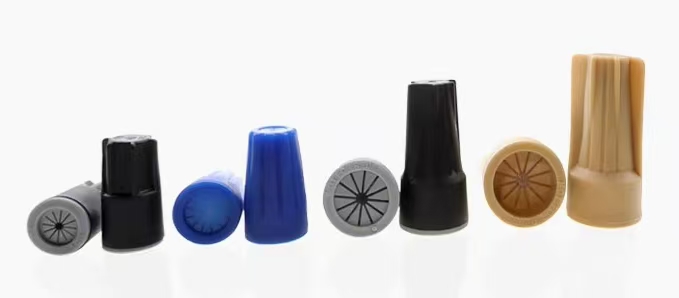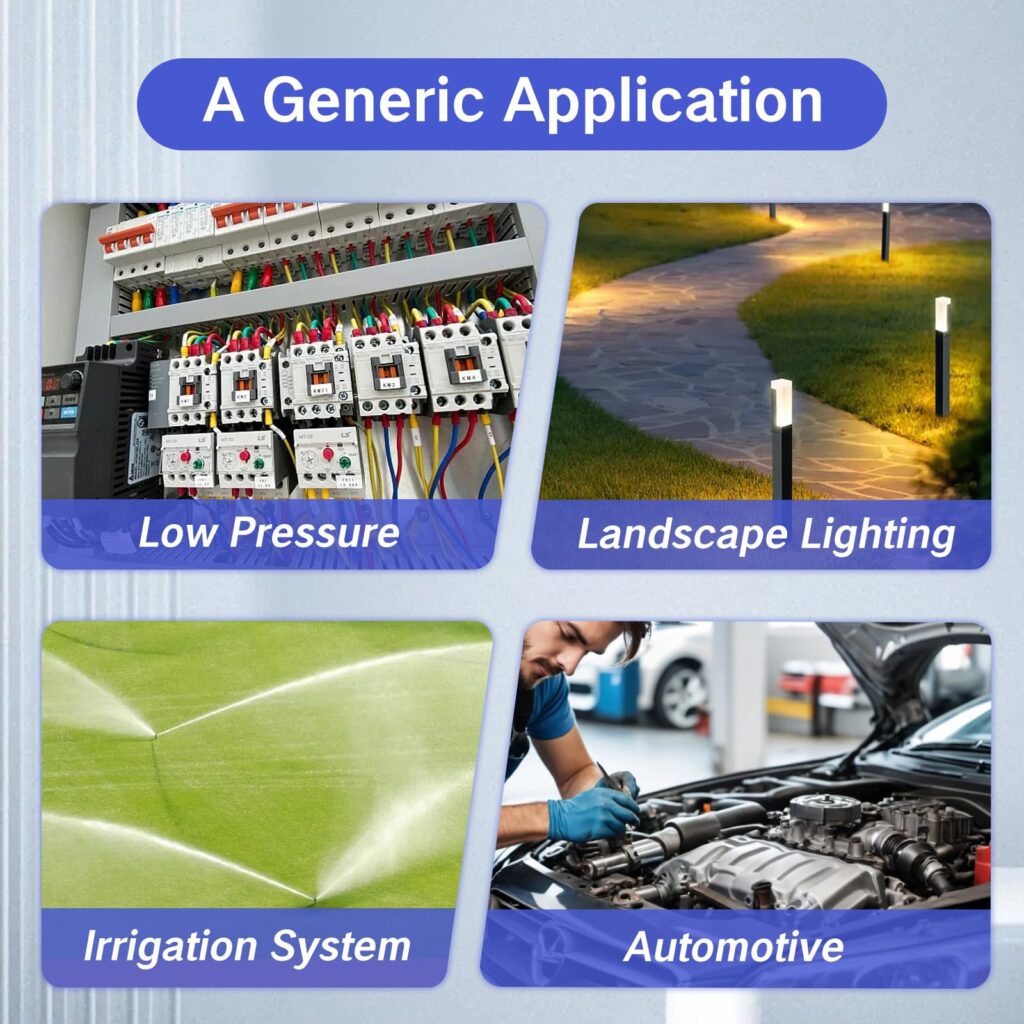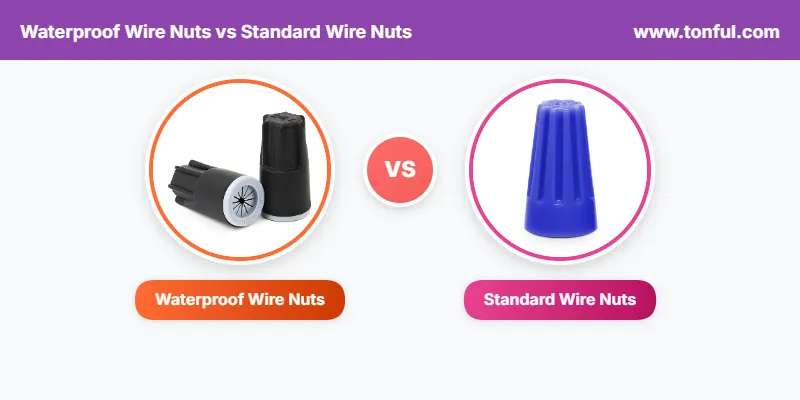What Are Wire Nuts? Essential Definitions

Standard Wire Nuts are twist-on electrical connectors with a plastic shell and internal metal spring that mechanically joins two or more electrical wires together. They provide basic insulation and strain relief but offer no protection against moisture infiltration.
Waterproof Wire Nuts (also called weatherproof wire connectors or wet-location wire nuts) are specialized connectors that combine the mechanical connection of standard wire nuts with integrated moisture barriers. They contain silicone sealant or dielectric gel that completely encapsulates the wire connection, creating an IP-rated seal that prevents water, dirt, and corrosion.
Key Term Clarifications:
- IP Rating: Ingress Protection rating that indicates the level of protection against water and dust (waterproof wire nuts typically rated IP67 or IP68)
- Wet Location: Areas exposed to water saturation or weather exposure, as defined by NEC Article 100
- Damp Location: Partially protected areas subject to moderate moisture, as defined by NEC Article 100
- Dielectric Seal: Non-conductive barrier that prevents electrical current leakage and moisture penetration
Key Differences: Waterproof vs Standard Wire Nuts Comparison
Here is a table that shows the critical differences between waterproof and standard wire nuts:
| Feature | Standard Wire Nuts | Waterproof Wire Nuts |
|---|---|---|
| Moisture Protection | None (moisture can enter) | Complete seal with silicone/gel barrier |
| Primary Use Location | Dry indoor locations only | Outdoor, underground, wet locations |
| Internal Design | Metal spring coil only | Metal spring + sealant fill |
| NEC Compliance | Dry locations per Article 110.11 | Wet locations per Article 110.11 and 406.9 |
| IP Rating | Not rated (no ingress protection) | IP65, IP67, or IP68 certified |
| Installation Method | Twist-on connection | Twist-on + compression seal activation |
| Corrosion Prevention | No protection mechanism | Active corrosion prevention via encapsulation |
| Price Range | $0.10 – $0.50 per connector | $0.50 – $2.00 per connector |
| Reusability | Can be removed and reused | Single-use only (seal compromised when removed) |
| Temperature Range | -40°F to 221°F (-40°C to 105°C) | -40°F to 221°F with maintained seal integrity |
| Wire Gauge Capacity | 22 AWG to 6 AWG typical | 22 AWG to 10 AWG typical |
| Color Coding | Gray, blue, orange, red, yellow | Black, gray (limited color options) |
| UL Listing Required | UL 486C (wire connectors) | UL 486C plus wet location testing |
How Waterproof Wire Nuts Work: Construction Details
Waterproof wire nuts protect electrical connections through a three-layer protection system:
Layer 1: Mechanical Connection
The internal metal spring coil grips and twists the stripped wire ends together, creating a secure mechanical and electrical bond identical to standard wire nuts.
Layer 2: Silicone Sealant
Pre-filled dielectric silicone gel or compound surrounds the metal spring. When you twist the connector onto the wires, this sealant flows around and completely encapsulates the exposed copper conductors.
Layer 3: Outer Shell Seal
The plastic housing features enhanced sealing ridges or gaskets at the wire entry point. As you tighten the connector, these ridges compress against the wire insulation, creating a waterproof barrier at the most vulnerable entry point.
Active Protection Mechanisms:
- Corrosion Prevention: Silicone gel displaces oxygen and moisture, preventing oxidation of copper conductors
- Pressure Sealing: Installation torque activates compression seal around wire jacket
- Self-Healing Properties: Some premium waterproof wire nuts use gel that reseals around minor punctures
- Capillary Blocking: Gel prevents water migration along wire strands through capillary action
What Makes Waterproof Wire Nuts Different? Critical Performance Factors
Moisture Barrier Technology
Standard wire nuts leave gaps where moisture can wick along wire strands through capillary action. Even in seemingly dry locations, humidity can condense inside standard connections, causing slow corrosion over months or years.
Waterproof wire nuts eliminate this risk entirely. The silicone sealant creates a positive moisture barrier that physically blocks water molecules from reaching the copper connection. This protection extends to:
- Direct water spray and submersion
- Ground moisture and soil contact
- Condensation from temperature cycling
- Salt spray in coastal environments
- Chemical exposure in industrial settings
NEC Code Compliance Requirements
The National Electrical Code (NEC) mandates specific connector types based on location conditions:
Article 110.11 requires all electrical connections to be suitable for the environmental conditions of use. This means you must use waterproof-rated connectors in wet locations, not standard wire nuts.
Article 406.9(B)(1) specifies that outlets and connectors in wet locations must be identified for use in wet locations. This requirement extends to wire connectors used in these installations.
Article 300.5 governs underground installations and requires moisture-resistant connections for direct burial applications. Standard wire nuts do not meet this requirement.
Important: Using standard wire nuts in wet locations is a code violation that can result in failed inspections, insurance claim denials, and serious safety hazards.
When to Use Waterproof Wire Nuts: Applications Guide

Outdoor Installations (Required)
You need waterproof wire nuts for all outdoor electrical connections, including:
- Landscape Lighting Systems: Low-voltage and line-voltage outdoor fixtures
- Outdoor Outlet Boxes: Weather-resistant receptacles and junction boxes
- Security Camera Installations: Power and data connections exposed to weather
- Pool and Spa Equipment: Pump connections, heater wiring, and control circuits
- Sprinkler System Valves: Solenoid connections and timer wiring
- Deck and Patio Lighting: Post lights, step lights, and under-rail fixtures
- Driveway Gate Operators: Motor power and control circuits
- Outdoor HVAC Units: Condenser connections and disconnect wiring
Underground and Direct Burial (Required)
Waterproof wire nuts are mandatory for direct burial applications:
- Underground Feeder Circuits: Service runs from meter to detached structures
- Landscape Power Distribution: Buried cables feeding outdoor outlets and lights
- Well Pump Wiring: Submersible pump connections and control boxes
- Underground Sprinkler Systems: Valve wiring and controller connections
- Pathway Lighting Circuits: Direct burial cables for walkway illumination
- Geothermal System Connections: Ground loop sensor and control wiring
Wet and Damp Indoor Locations (Recommended)
Use waterproof wire nuts in interior locations with moisture exposure:
- Bathrooms: Fixture connections near showers and tubs
- Basements: Junction boxes in areas prone to flooding or high humidity
- Crawl Spaces: All connections in unconditioned below-grade areas
- Laundry Rooms: Washer and dryer connections, utility sink circuits
- Unheated Garages: Locations subject to condensation from temperature swings
- Kitchen Backsplash Areas: Connections behind sinks and near dishwashers
When Standard Wire Nuts Are Appropriate
You can safely use standard wire nuts in:
- Dry interior junction boxes in conditioned spaces
- Residential branch circuits in finished living areas
- Panel board connections in climate-controlled rooms
- Ceiling fixture connections in dry locations
- Wall switch and outlet box connections in standard rooms
Safety Note: When in doubt, choose waterproof wire nuts. The minimal additional cost provides significant long-term protection and peace of mind.
How to Choose the Right Wire Nuts: Selection Criteria
Step-by-Step Selection Process
Step 1: Determine Environmental Conditions
Assess the installation location:
- Is it exposed to direct weather, spray, or submersion? → Waterproof required
- Is it in contact with ground or soil? → Waterproof required
- Is it in an unconditioned space with potential condensation? → Waterproof recommended
- Is it in a finished, dry interior space? → Standard acceptable
Step 2: Check Wire Gauge and Quantity
Count the wires you need to connect and note their gauge:
- 2-3 wires, 14 AWG → Small waterproof or standard connector
- 2-3 wires, 12 AWG → Medium waterproof or standard connector
- 4+ wires, 14-12 AWG → Large waterproof or standard connector
- 10 AWG or larger → Specialty waterproof connector required
Step 3: Verify Code Requirements
Consult NEC Articles 110.11, 300.5, and 406.9 for your specific application. Local amendments may impose additional requirements. When applying for permits, inspectors will verify proper connector ratings for the installation location.
Step 4: Confirm IP Rating (for waterproof connectors)
Match the IP rating to your exposure level:
- IP65: Protected against water jets, suitable for most outdoor boxes
- IP67: Submersion up to 1 meter for 30 minutes, ideal for ground-level installations
- IP68: Continuous submersion beyond 1 meter, required for direct burial and submerged applications
Step 5: Calculate Quantity and Cost
Waterproof wire nuts cost 3-5 times more than standard connectors, but this represents minimal expense compared to repair costs from moisture damage. Budget approximately:
- Standard wire nuts: $5-15 per 100-pack
- Waterproof wire nuts: $20-60 per 25-50 pack
Critical Selection Factors
Wire Compatibility
Ensure the connector accommodates both the wire gauge and insulation type (THHN, THWN, XHHW). Waterproof wire nuts require sufficient wire insulation coverage to seal properly against the jacket.
Temperature Rating
Both standard and waterproof wire nuts typically handle -40°F to 221°F, but verify ratings for extreme applications like outdoor fixtures in extreme climates or near heat sources.
Voltage Rating
Most wire nuts are rated for 600V, sufficient for residential and light commercial applications. Verify ratings for specialized applications.
Brand Quality
Choose UL-listed connectors from established manufacturers. Premium brands include:
- King Innovation (WeatherProof connectors)
- 3M (Scotchlok connectors)
- Ideal Industries (Wire-Nut and WeatherProof series)
- Gardner Bender (Wingtwist and Waterproof series)
Installation Guide: How to Properly Install Waterproof Wire Nuts
Standard Wire Nut Installation (5 Steps)
- Strip Wire Insulation
Remove 5/8 to 3/4 inch of insulation from each wire end using wire strippers. Strip length must match the connector’s wire insertion depth. - Align and Pre-Twist
Hold the stripped wire ends parallel and even. Pre-twist the bare copper conductors 1-2 turns clockwise by hand to start the connection. - Apply Wire Nut
Place the wire nut over the pre-twisted wires and twist clockwise firmly until you feel resistance. Continue twisting 2-3 more turns past initial resistance. - Verify Connection
Gently tug each wire to confirm secure mechanical connection. No wire should pull free. Inspect to ensure no bare copper is visible outside the connector. - Secure in Box
Fold wires into the junction box carefully, ensuring no strain on the connection. Install cover plate or fixture.
Waterproof Wire Nut Installation (7 Steps)
- Verify Dry Conditions
Ensure all wires and connections are completely dry before installation. Waterproof wire nuts seal moisture out, but they also seal moisture in if applied to wet wires. - Strip Wire Insulation Precisely
Remove exactly 5/8 inch of insulation. Precision is critical because the seal forms against the wire jacket, not the bare copper. - Align Wires Perfectly
Hold stripped ends exactly even. Uneven wires prevent proper sealant distribution and compromise the waterproof seal. - Apply Connector with Force
Twist the waterproof wire nut onto the aligned wires using firm, continuous clockwise rotation. You’ll feel significantly more resistance than standard wire nuts due to the internal sealant. - Continue Past Resistance
Keep twisting until the connector stops turning completely. This final compression activates the full moisture seal. Typically requires 5-7 full rotations. - Verify Sealant Flow
Inspect the wire entry point. You should see a small amount of clear silicone or gel squeezed out around the wire insulation, indicating complete sealant coverage. - Allow Cure Time
Some waterproof wire nuts require 15-30 minutes for the sealant to set before burial or final installation. Check manufacturer specifications.
Expert Installation Tips:
- Use a wire nut wrench for consistent torque and easier installation of waterproof connectors
- Never reuse waterproof wire nuts; the seal is permanently compromised after removal
- Avoid twisting wires together before applying waterproof wire nuts; let the connector do all the work
- Keep spare waterproof connectors on hand; mistakes require starting over with a new connector
Safety Warnings and Code Compliance
Critical Safety Requirements
⚠️ WARNING: Electrical Shock Hazard
Always turn off circuit breakers and verify power is off with a non-contact voltage tester before working on any electrical connections. Even “dead” circuits can be energized by backfeeding or miswiring.
⚠️ WARNING: Fire Hazard
Using standard wire nuts in wet locations creates arcing and overheating risks that can ignite surrounding materials. Moisture in electrical connections causes resistance buildup, leading to dangerous heat generation.
⚠️ WARNING: Electrocution Risk
Compromised connections in outdoor and underground applications can energize metal enclosures, conduit, and equipment housings. This creates lethal shock hazards to anyone contacting these surfaces.
NEC Code Compliance Checklist
- Connectors rated for wet locations in outdoor installations (NEC 110.11)
- Direct burial connectors for underground applications (NEC 300.5)
- Proper wire gauge capacity verified (NEC 110.14)
- Correct wire fill in junction boxes (NEC 314.16)
- Waterproof boxes and covers for outdoor connections (NEC 314.15)
- GFCI protection for required outdoor circuits (NEC 210.8)
- All connections accessible for inspection and maintenance (NEC 300.15)
When to Call a Licensed Electrician
You should hire a professional electrician for:
- Service entrance connections and meter installations
- Underground feeder circuits over 50 feet
- Connections involving wire sizes larger than 10 AWG
- Installations requiring permits and inspections
- Pool, spa, and hot tub electrical systems
- Any work you’re uncomfortable or uncertain about
Troubleshooting Common Wire Nut Problems
Standard Wire Nut Issues
Problem: Wire Pulls Out of Connector
- Cause: Insufficient twisting, wrong size connector, or damaged internal spring
- Solution: Remove connector, trim damaged wire ends, select proper size, and reinstall with firm twisting until tight
Problem: Bare Copper Visible Outside Connector
- Cause: Excessive wire strip length or inadequate twisting
- Solution: Remove connector, trim wires to proper strip length (5/8″), and reinstall completely
Problem: Connection Feels Loose
- Cause: Wrong size connector for wire gauge or strand count
- Solution: Select larger connector size and reinstall
Waterproof Wire Nut Issues
Problem: Sealant Doesn’t Squeeze Out
- Cause: Insufficient twisting or defective connector
- Solution: Continue twisting forcefully; if connector spins freely, discard and use new connector
Problem: Water Still Enters Connection
- Cause: Improper installation, damaged wire insulation, or connector defect
- Solution: Remove and discard connector, inspect wire insulation for damage, replace damaged wire section, and install new waterproof connector properly
Problem: Difficult to Twist On
- Cause: Normal resistance from internal sealant
- Solution: Use wire nut wrench or pliers for additional leverage; maintain steady clockwise pressure
Problem: Connection Fails After Installation
- Cause: Water trapped during installation or pre-existing wire corrosion
- Solution: Remove connector, cut back wires to fresh copper, ensure completely dry, install new waterproof connector
Expert Tips for Professional-Quality Connections
Tip #1: Pre-Test Your Technique
Before critical installations, practice with spare wire and connectors to develop proper feel for adequate tightness. This is especially important with waterproof wire nuts that require more torque.
Tip #2: Invest in Quality Tools
A good wire nut wrench ($15-30) provides consistent torque and prevents hand fatigue during large installations. Ratcheting wire strippers ($20-40) ensure perfectly consistent strip lengths.
Tip #3: Buy Connectors in Assorted Packs
Purchase variety packs containing multiple sizes. Having the right size available prevents compromise installations with wrong-sized connectors.
Tip #4: Mark Waterproof Connections
Use permanent marker on the connector body to note installation date and circuit. This helps future troubleshooting and maintenance.
Tip #5: Upgrade Questionable Connections
When working in junction boxes, replace any marginal standard wire nuts with waterproof versions in damp locations. The small additional cost prevents future callbacks.
Tip #6: Document Your Installations
Photograph completed connections before closing junction boxes, especially for buried or inaccessible locations. These records are invaluable for future modifications.
Quick Reference: Wire Nut Selection Chart
Here is a table that shows proper wire nut selection by application:
| Application Type | Connector Required | Typical Size | Key Requirements |
|---|---|---|---|
| Dry indoor junction boxes | Standard wire nut | Match wire gauge | UL 486C listed |
| Outdoor fixtures | Waterproof wire nut | Medium-Large | IP65+ rating |
| Direct burial | Waterproof wire nut | Medium | IP67-IP68 rating |
| Landscape lighting | Waterproof wire nut | Small-Medium | Direct burial rated |
| Bathroom fixtures | Waterproof wire nut (recommended) | Small-Medium | Moisture resistant |
| Basement junction boxes | Waterproof wire nut (recommended) | Match wire gauge | Corrosion resistant |
| Pool/spa equipment | Waterproof wire nut | Medium-Large | IP68 + UL wet location |
| Underground service | Waterproof wire nut | Large | Direct burial + 600V rated |
Frequently Asked Questions
Can you use waterproof wire nuts indoors?
Yes, you can use waterproof wire nuts anywhere you would use standard wire nuts. While more expensive, they provide superior long-term protection in damp locations like basements, bathrooms, and crawl spaces. However, they’re overkill for standard dry indoor applications.
Do waterproof wire nuts really prevent all water damage?
Waterproof wire nuts prevent moisture damage when properly installed on dry, undamaged wires. They cannot compensate for damaged wire insulation, improper installation, or wires already corroded before installation. The seal is only as good as the installation technique and wire condition.
Can you reuse waterproof wire nuts?
No, waterproof wire nuts are single-use connectors. Removing them compromises the internal seal and sealant distribution, eliminating moisture protection. Always use a new waterproof wire nut when modifying or repairing connections.
What’s the difference between damp-rated and wet-rated wire nuts?
Damp-rated connectors handle condensation and indirect moisture but not direct water exposure. Wet-rated connectors (waterproof wire nuts) withstand direct water contact, spray, and submersion. For outdoor use, always choose wet-rated connectors with appropriate IP ratings.
How long do waterproof wire nuts last underground?
Properly installed waterproof wire nuts with IP67 or IP68 ratings last 20-30+ years in direct burial applications. Lifespan depends on soil conditions, installation quality, and wire insulation integrity. Coastal and high-moisture environments may reduce longevity.
Are color-coded waterproof wire nuts available?
Waterproof wire nuts typically come in black or gray only, unlike standard wire nuts with extensive color coding. Size selection is based on package specifications rather than color, as the sealant fill makes traditional color-coding systems impractical.
Can waterproof wire nuts be used with aluminum wire?
Only use waterproof wire nuts specifically rated for aluminum conductors (marked “AL/CU”). Most waterproof wire nuts are designed for copper only. Using copper-only connectors with aluminum wire creates fire hazards due to galvanic corrosion and different expansion rates.
Do you need waterproof wire nuts in conduit?
Yes, if the conduit is in a wet location or underground, you need waterproof wire nuts. Conduit is not moisture-proof; water enters through couplings, fittings, and condensation. NEC requires wet-location connectors regardless of conduit type in wet locations.
Conclusion: Making the Right Wire Nut Choice
The difference between waterproof and standard wire nuts comes down to environmental protection. Standard wire nuts work perfectly for dry indoor applications where moisture exposure is unlikely. Waterproof wire nuts are essential for outdoor, underground, and wet location installations where moisture could compromise connections.
Choosing the correct wire nut type ensures:
- Safety: Prevents electrical shocks, fires, and equipment damage from moisture-related failures
- Code Compliance: Meets NEC requirements and passes inspections
- Longevity: Protects connections from corrosion and degradation over decades
- Reliability: Eliminates nuisance failures and expensive service calls
When in doubt, invest in waterproof wire nuts. The minimal cost difference (typically $10-20 per project) provides substantial protection against moisture-related failures that could cost hundreds or thousands in repairs.
For complex installations, outdoor service upgrades, or applications involving direct burial, consult a licensed electrician to ensure proper connector selection, installation, and code compliance. Your electrical safety is worth the professional expertise.
Take Action Now: Review your existing outdoor and basement electrical connections. If you find standard wire nuts in wet or damp locations, schedule time to upgrade them to properly-rated waterproof connectors. This simple improvement significantly enhances your electrical system’s safety and reliability.

